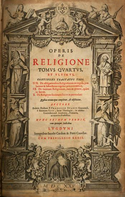| Part of the series on Modern scholasticism | |

| |
| Title page of the Operis de religione (1625) from Francisco Suárez. | |
| Background | |
|---|---|
|
Protestant Reformation | |
| Modern scholastics | |
|
Second scholasticism of the School of Salamanca | |
| Reactions within Christianity | |
|
The Jesuits against Jansenism | |
| Reactions within philosophy | |
|
Neologists against Lutherans | |
Nadere Reformatie (Dutch Second Reformation or Further Reformation[1]) is the period of church history in the Netherlands, following the Reformation, from roughly 1600 until 1750.
YouTube Encyclopedic
-
1/3Views:4725 0159 713
-
TRANSLATION COMMITTEE's collections ::::coming soon::::
-
Self Denial Defined - Wilhelmus a Brakel
-
The Power of Indwelling Corruption: The Christian's Reasonable Service - Wilhelmus à Brakel
Transcription
History
The period and its representatives are known for their desire to apply the principles of the Reformation to their day – their homes, churches, and, indeed, all sectors of Dutch society in the seventeenth and early eighteenth century. In their balance and value of both orthodoxy as well as piety, the Nadere Reformatie resembles English Puritanism and German Pietism.[2]
In fact, Puritanism had much influence on the Nadere Reformatie. Many Puritan works were translated into Dutch during this time. Moreover, many Dutch visiting students learned about Puritan ideas from English universities.[3]
The two leading figures of the period are a professor, Gisbertus Voetius, and a pastor, Wilhelmus à Brakel. Brakel's main work, the Redelijke Godsdienst, an explanation, defense, and application of the Reformed faith, has been translated into English.[4]
Notable figures
- Jean Taffin (1529–1602)
- Willem Teellinck (1579–1629)
- Godefridus Udemans (c.1581-1649)
- Gisbertus Voetius (1589–1676)
- Johannes Hoornbeeck (1617–1666)
- Andreas Essenius (1618–1677)
- Jodocus van Lodenstein (1620–1677)
- Petrus van Mastricht (1630–1706)
- Simon Oomius (1630–1706)
- Jacobus Koelman (1632–1695)
- Wilhelmus à Brakel (1635–1711)
- Hermanus Witsius (1636–1708)
- Wilhelmus Schortinghuis (1700–1750)
References
- ^ Herman Selderhuis, ed. (2015). "The Further Reformation". Handbook of Dutch Church History. Bristol, CT: Vandenhoeck & Ruprecht. pp. 338–341. ISBN 978-3-525-55787-7.
- ^ van Lieburg, Fred (2014). "Dynamics of Dutch Calvinism: Early Modern Programs for Further Reformation". Calvinism and the Making of the European Mind. Leiden: Brill. pp. 43–66. ISBN 978-90-04-28005-2.
- ^ Milton, Anthony (2008). "Puritanism and the continental Reformed churches". In John Coffey; Paul C. H. Lim (eds.). The Cambridge Companion to Puritanism. Cambridge: Cambridge University Press. pp. 118–119. ISBN 978-1-139-82782-9.
- ^ À Brakel, Wilhemus (2015). The Christian's Reasonable Service, 4 Vols [De Redelijke Godsdienst]. Translated by Elshout, Bartel. Grand Rapids, MI: Reformation Heritage Books. ISBN 978-1-60178-131-4.
